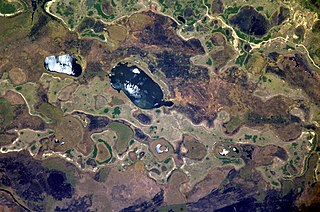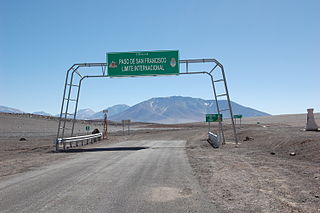Laguna Verde, the Spanish-language form of green lagoon or green lake, may refer to:

Carchi is a province in Ecuador. The capital is Tulcán. The Carchi River rises on the slopes of Chiles volcano and forms the boundary between Colombia and Ecuador near Tulcan. Rumichaca Bridge is the most important land route between Colombia and Ecuador.

The Iberá Wetlands are a mix of swamps, bogs, stagnant lakes, lagoons, natural slough, and courses of water in the center and center-north of the province of Corrientes, Argentina.

Laguna San Rafael National Park is a park located on the Pacific coast of southern Chile. The park is named for the San Rafael Lagoon formed by the retreat of the San Rafael Glacier. Created in 1959, it covers an area of 17,420 km2 (6,726 sq mi) and includes the Northern Patagonian Ice Field. A fjord more than 16 km (10 mi) long is one of the park's principal attractions.

The Puelo River has its origin in Lake Puelo in Argentine, and flows north-west through the Andes into Chile and the Reloncaví Estuary of the Reloncaví Sound at the northern end of the Gulf of Ancud.

Nevado Tres Cruces National Park is a national park located in the Atacama Region of Chile, east of Copiapó. It includes Laguna Santa Rosa, Laguna del Negro Francisco, and a part of the Salar de Maricunga. The park is divided into two zones, the northern zone encompassing the southern portion of Salar de Maricunga and Laguna Santa Rosa, and the southern area the Laguna del Negro Francisco. The park is named after Nevado Tres Cruces, which dominates the landscape of the area. The park is managed by the Corporación Nacional Forestal, which offers two refuges in the area: one at the south of Negro Francisco Lagoon and other at the west of Santa Rosa Lagoon. The park is open from October to April.

Laguna Verde is a salt lake in the Andes Mountains of Chile. It lies in the Atacama Region, near San Francisco Pass. The stratovolcano Ojos del Salado, on the border with Argentina, marks the south border of its basin.

Los Flamencos National Reserve is a nature reserve located in the commune of San Pedro de Atacama, Antofagasta Region of northern Chile. The reserve covers a total area of 740 square kilometres (290 sq mi) in the Central Andean dry puna ecoregion and consists of seven separate sections.

The Andean coot, also known as the slate-coloured coot, is a species of bird in the family Rallidae. It is found in the Andes from far southwestern Colombia to northwestern Argentina. Its natural habitats are swamps and freshwater lakes. Fossils tentatively assigned to this species are known from the Laguna de Tagua Tagua formation of Chile.

The red-gartered coot is a species of bird in the family Rallidae. On average, it grows to 45 cm (18 in) in length, which exceeds that of most coots. It is found in Argentina, southern Brazil, Chile, Paraguay and Uruguay, and is a vagrant to Bolivia and the Malvinas Islands. Its natural habitats are swamps and freshwater lakes. Fossils of this species are known from the Laguna de Tagua Tagua formation of Chile.

The red-fronted coot is a species of bird in the family Rallidae. At 36–43 cm (14–17 in), it is a mid-sized species of coot. It is found in Argentina, southern Brazil, Chile, Paraguay, southern Peru and Uruguay. There are also records from Bolivia and the Falkland Islands. Its natural habitat is swamps and well-vegetated lakes and ponds. Fossils of this species are known from the Laguna de Tagua Tagua formation of Chile.

The plumbeous rail is a species of bird in the family Rallidae. It is found in Argentina, Bolivia, Brazil, Chile, Ecuador, Paraguay, Peru and Uruguay, and is a vagrant to the Falkland Islands. Its natural habitat is swamps. Adult plumbeous rail are distinguished by their gray and brown plumage and long colorful bill. The plumbeous rail is the only long-billed rail expected to be found in the Andean marshes with the exception of the rare Bogota rail. Fossils of this species are known from the Laguna de Tagua Tagua formation of Chile.

Laguna Colorada is a shallow salt lake in the southwest of the altiplano of Bolivia, within Eduardo Avaroa Andean Fauna National Reserve and close to the border with Chile.

The San Francisco Pass is a pass over the Andes mountains which connects Argentina and Chile. The highest point of this pass is at 4,726 m (15,505 ft) AMSL.
Pucará de Cerro La Muralla is an Inca Pucara (fortress) in Chile. It is located on a strategic mountain top, five km to the south of San Vicente de Tagua Tagua, near the dry lagoon. This is believed to be the southernmost fort of the Inca Empire.
Laguna Torca National Reserve is a national reserve of Chile's Maule Region. Laguna Torca is 200 kilometres (120 mi) South-West of Santiago, in the Maule Region 7. Situated a bare 3 kilometres (1.9 mi) from the Pacific Ocean and adjoins Lago Vichuquen, in the coastal mountains. The fresh water in the laguna comes from these local mountains, rather than the inland Andes.

The Laguna del Desierto incident occurred between four Chilean Carabineros and between 40 and 90 members of the Argentine National Gendarmerie and took place in an area south of O'Higgins/San Martín Lake on 6 November 1965, resulting in one lieutenant killed and a sergeant injured, both members of Carabineros, creating a tense atmosphere between Chile and Argentina.

The Del Desierto lake or Lake of the Desert is a lake, located in the Lago Argentino Department, Santa Cruz Province, Argentina. The lake, located near the mount Fitz Roy and the O'Higgins/San Martín Lake, has been the subject of a territorial dispute between Argentina and Chile, escalating to a small battle on 6 November 1965 when 40 to 90 members of the Argentine Gendarmerie fought against four Chilean Carabineros resulting the lieutenant Hernán Merino killed and a sergeant injured, both members of Carabineros, the dispute was solved favourably for Argentina in 1994 with an arbitration.

Laguna del Maule is a volcanic field in the Andes mountain range of Chile, close to, and partly overlapping, the Argentina–Chile border. The bulk of the volcanic field is in the Talca Province of Chile's Maule Region. It is a segment of the Southern Volcanic Zone, part of the Andean Volcanic Belt. The volcanic field covers an area of 500 km2 (190 sq mi) and features at least 130 volcanic vents. Volcanic activity has generated cones, lava domes, lava coulees and lava flows, which surround the Laguna del Maule lake. The field gets its name from the lake, which is also the source of the Maule River.
















